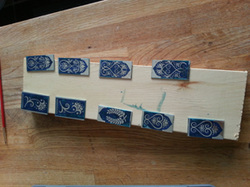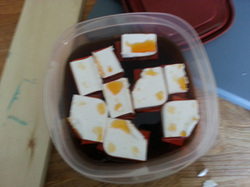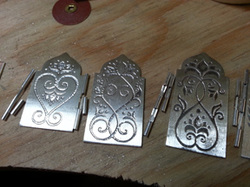|
A few years ago my husband joined the SCA (http://www.sca.org). For those of you unfamiliar with it, here is a brief introduction from their website. The SCA is an international organization dedicated to researching and re-creating the arts and skills of pre-17th-century Europe. Our "Known World" consists of 19 kingdoms, with over 30,000 members residing in countries around the world. Members, dressed in clothing of the Middle Ages and Renaissance, attend events which feature tournaments, royal courts, feasts, dancing, various classes & workshops, and more.” Now my husband joined for the fun of the armoured combat. Where else can you make your own armour and go fight each other with sticks. I haven't made it to many of the events but I'm getting to know a lot of people and starting to try to get into the arts scene in there. I'm always been a fan of history so what better excuse to look into my interests more than finding a hobby to match. Last summer a friend of ours approached me, she was just stepping up as Princess of Avacal, and she wanted to have me make her coronet that she would wear as Viscountess after she finished her term as Princess. Finding out I love to enamel was just the icing on the cake!  Within the SCA we try to keep things period. There are a many cultures and time frames from which to choose. For this project we are working with a Russian persona, and this is the reference she provided me with for the type of coronet she wanted done. A series of enameled silver plates, hinged, topped with pearls to be secures to the head with a ribbon tied to the back, and without the religious iconography. And so the designing began. We wanted to make sure the wreath of laurel leaves was included as she is a member of the Order of the Laurel (a rank of peerage within the Arts and Sciences), otherwise I was free to design as I saw fit. I wanted to stick with the Russian designs and spent a great deal of time looking searching for medieval references of jewellery styles. What I discovered was that the enamel pieces tended towards pattern and ornamentation that reminded me of some of the Russian embroidery I had seen. After going through many images I sat down and started sketching, making my own variation of these patterns which I thought would suit this piece.  This is the finalized design I came up and got the go-ahead to start creating. The black areas will be the metal showing and the whites areas will be etched away and willed with enamel, a powdered glass that is fused to the silver.  Here we see the pieces of silver after they have been prepped for etching. The etching process requires the metal be grease free, and spot that is not free of grease will not etch (I have seen pieces that ended up with fingerprints show up after etching when the metal isn't clean enough) I then ironed the resist onto the metal (I may do a more in depth explaination of this etching process at some point, but for now I'll just stick with a brief rundown) and sealed the back and edges of the metal, essentially anything I didn't want to etch and touched up a few spots that didn't iron on well.  At this point I attached the sliver to styrofoam pieces and had them float in the etching solution. The floating is necessary depending on what type of etching solution you are using. I personally have now interest in working with the harsher acids, this ferric nitrate solution is works just fine for me and is not as harsh of a chemical as having to work with nitric acid. They sat in the solution etching for a few hours before being neutralized and cleaned up.  Here are a few of the pieces after being cleaned up and cut out. Stay tuned for part 2.
0 Comments
Leave a Reply. |
Michelle Sparks
Designer, Artist, Mother of one with more ideas than she knows what to do with. Archives
May 2013
Categories |

 RSS Feed
RSS Feed
